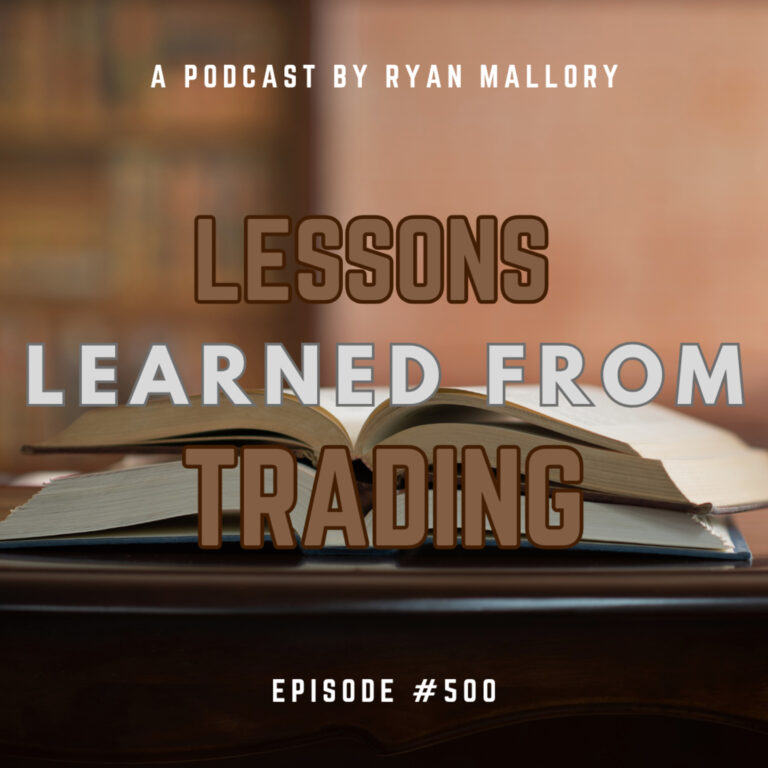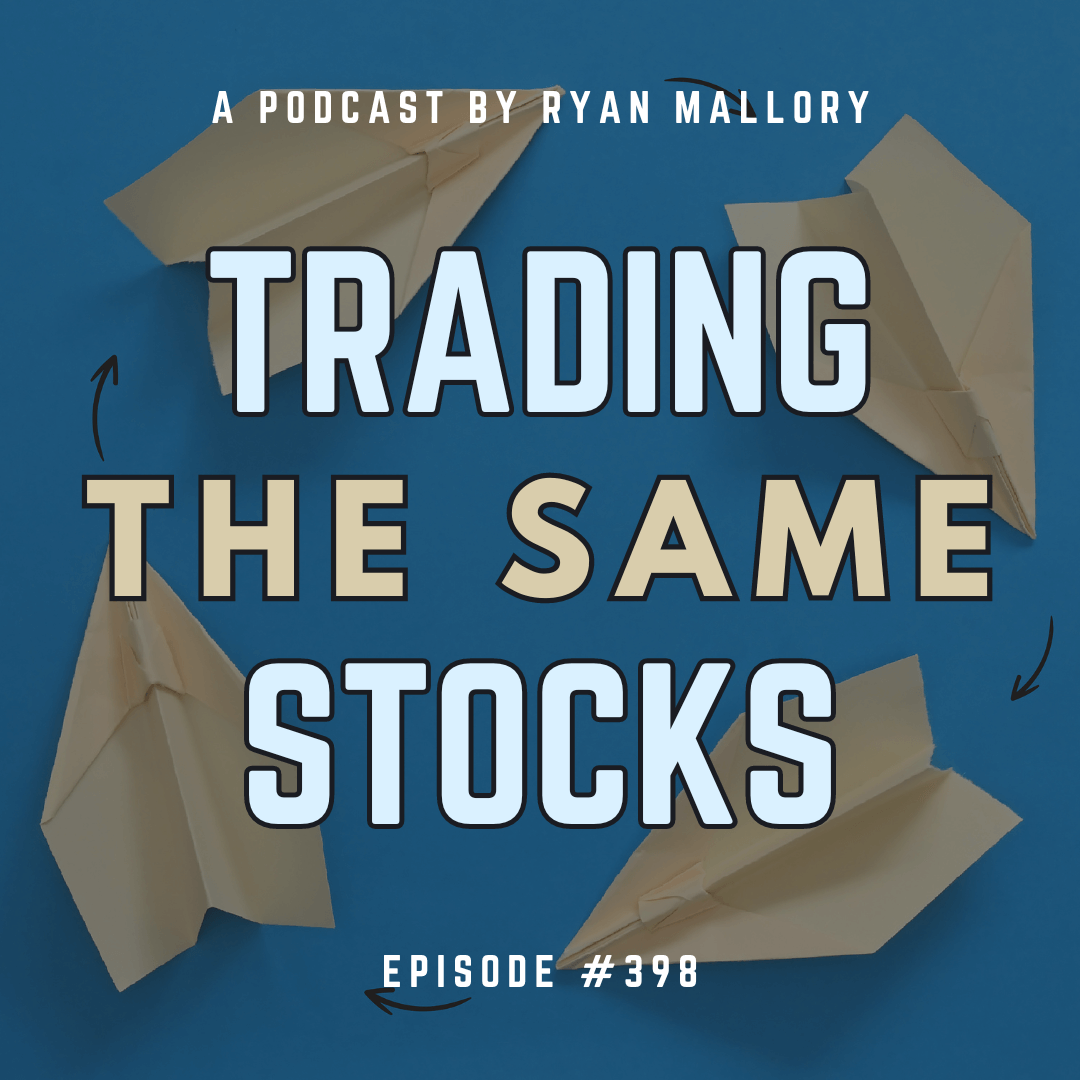Episode Overview
Ryan discusses whether one should avoid trading the same stocks multiple times in a short period of time. Also discusses the impact of the wash sale rule as it pertains to swing trading.
Available on: Apple Podcasts | Spotify | Amazon | YouTube
Episode Highlights & Timestamps
- [0:07] Introduction
Ryan introduces the episode with a question many traders face: should you re-enter the same stock after a stop-out? - [1:15] Atticus’s Question
A listener named Atticus asks about trading the same stock repeatedly and shares his conservative strategy developed since 2020. - [3:16] When to Re-Enter a Trade
Ryan discusses the emotions tied to jumping back into a stock after a loss and shares personal stories where this worked and when it didn’t. - [7:32] Understanding the Wash Sale Rule
A breakdown of what the wash sale rule is, with relatable analogies and how it may affect your taxes if ignored. - [12:13] Final Advice and Emotional Discipline
Ryan emphasizes staying emotionally grounded, avoiding revenge trading, and focusing on trade setups over tax implications.
Key Takeaways from This Episode:
- Re-Entering a Stock Is Okay, But Watch the Emotion: Trading the same stock more than once is fine if it’s a new setup, not an emotional reaction.
- Revenge Trading Is Dangerous: Trying to “win back” a loss from a specific stock often leads to poor decision-making.
- Know the Wash Sale Rule: If you sell a stock at a loss and buy it again within 30 days, you can’t claim that loss for taxes.
- Track Your Motives: Make sure you’re entering trades based on strategy, not frustration or attachment to a stock.
- Cash Over Emotion: Sometimes the best trade is no trade at all. Staying in cash gives you control and clarity.
Resources & Links Mentioned:
- Swing Trading the Stock Market – Daily market analysis, trade setups, and insights by Ryan Mallory.
- Join the SharePlanner Trading Block – Get real-time trade alerts and community support.

Take the Next Step:
✅ Stay Connected: Subscribe to Ryan’s newsletter to get free access to Ryan’s Swing Trading Resource Library, along with receiving actionable swing trading strategies and risk management tips delivered straight to your inbox.
📈 Level Up Your Trading: Ready for structured training? Enroll in Ryan’s Swing Trading Mastery Course, The Self-Made Trader, and get the complete trading course, from the foundational elements of trading to advanced setups and profitable strategies.
📲 Join the Trading Community: Sign up for SharePlanner’s Trading Block to become part of Ryan’s swing-trading community, which includes all of Ryan’s real-time swing trades and live market analysis.
Full Episode Transcript
Click here to read the full transcript
0:07
Hey, I’m Ryan Mallory and this is my Swing Trading the Stock Market podcast. I’m here to teach you how to trade in a complex, ever changing world of finance.
0:16
Learn what it means to trade profitably and consistently, managing risk, avoiding the pitfalls of trading, and most importantly, to let those winners run wild.
0:25
You can succeed at the stock market, and I’m ready to show you how. Hey, everybody, this is Ryan Mallory with Swing Trading the Stock Market.
0:34
And today’s episode we’re going to talk about trading the same stock over and over again or even just, you know, you get stopped out of a stock and you hop right back into it.
0:42
Is that something that’s good to do, bad to do? You had things like the wash sale rule you got to be thinking about, right?
0:48
So we’re going to talk about that in this podcast episode. And today’s question from one of the listeners out there comes from a guy he’s asked to be called
0:59
Atticus for his Florida Redneck name. I don’t think I’ve come across too many atticuses.
1:05
I don’t know how you even say Atticus in a plural manner, but I think that might just be more of a southern name in general, Like broad southern, Deep South name.
1:15
OK, so any case, not to get too much into the details of Atticus, but Atticus writes, Dear Ryan, I am excited to have an excuse to mail you for your podcast.
1:25
I’d like my name to be Atticus if at all possible. Wish granted.
1:29
Obviously I am a fan of your podcast and have used your expertise to help my trading. I am still very amateur in my trading journey.
1:36
I started in 2020. It was my COVID hobby but I got more into it.
1:42
In the past few months while I am learning, I have been using a more conservative strategy. I have taken your advice to avoid penny stocks and stocks with volume less than 1,000,000 shares.
1:52
I have mainly been playing with Fortune 500 stocks because while Walmart stock can hit zero tomorrow, it’s unlikely that these stocks will take huge losses overnight, though anything is
2:01
possible. I am working on getting better at reading charts, but I have been trying to catch a swing that will
2:06
profit me 5 to 10% with a stop loss of about 2 1/2 percent. My question is, is how often do you buy and sell the same stock?
2:13
For example, if I buy and sell Intel this week, that’s INTC, but I see them setting up for a potential profit five weeks or even six weeks from now.
2:22
Can I buy and sell them? Again, I can probably Google this, but I wanted to ask you sincerely, Atticus, God bless.
2:29
I am a believer too. That’s great.
2:30
And for those who don’t know what that means when you say I’m a believer, because I know there’s people in multiple countries that listen to this podcast, this is an expression that Christians use
2:39
to identify as a follower of Jesus Christ. So really cool to get somebody that shares similar faith to identify in that way.
2:46
Any case, what are we talking about here When it comes to trading the same stock multiple times? I have no problem buying the same stock not only just five or six weeks down the road like Atticus
2:59
talks about here, but also in the same day. I’ve done it many a time.
3:03
I prefer not to do it in the same day. The reason why is if I’m buying and selling the same stock twice in a given day usually means the
3:10
first time I was stopped out of a trade and somehow or another it’s setting back up again. That can happen.
3:16
Some of the times where I’ve seen it happen, the most of my trading has been when there’s been a big, huge downturn in the market and it looks like the market’s setting up for a bottom.
3:26
But because there’s so much volatility at market bottoms, you can get stopped out and then all of a sudden you see the market reverse and you’re off to the races.
3:34
And it can happen almost in the blink of an eye and you’re like, crap, the stock I just got stopped out of.
3:38
It’s setting back up again. It looks good.
3:40
I’m gonna go ahead and jump back into it, and I’ve done that a number of times over the years. Sometimes it works, sometimes it doesn’t.
3:47
I will say this, that the times that it doesn’t happen, it’s much more demoralizing when you feel like you just got taken out back by the same stock twice.
3:54
There was one I would say last year that I remember the best and that was SQ. It was the summer of last year and I got stopped out the first time for like a couple percent.
4:03
And then the next time I think I got stopped out for like 3 or 4%. And that second time it really just burned because it’s for one, you say to yourself, I shouldn’t
4:12
even trade it. The second time, I wouldn’t even have that loss.
4:14
But we’re not necessarily looking at stocks as, you know, a revenge trade. And that’s not what that was there either.
4:21
It actually did set up for a second time. And for a second time, the stock didn’t work in my favor.
4:26
It stinks when that happens. It’s humiliating.
4:29
It can even cause you to kind of doubt yourself at times when that starts to happen, because it just feels you question whether or not you should have done it.
4:36
Even though you may have been in the right to do it, it would have been a good trade set. Up.
4:40
It still feels foolish in hindsight to lose to the same stock twice within a day or within a couple of days.
4:46
It it really does. And the emotions on that second trade oftentimes run very, very high.
4:51
You’ll feel the emotions because it becomes more personal to you. So if you can avoid making a repeated stock in a trade like within a the same day or within a few
5:03
days. Now I know there’s exceptions to this.
5:04
There’s people who day trade and some people day trade and all they do is trade the same stock over and over.
5:09
I’ve met people over the years that all they do is day trade Apple. I’ve met people that all they do is day trade Tesla.
5:15
And I’m almost positive that there’s people out there right now that all they do is trade NVIDIA and that’s completely different.
5:23
That’s a strategy built around 1 stock. What I’m talking about is swing trading and getting stopped out of quickly of the same trade twice
5:30
when you don’t normally trade that stock that many times within a short period of time. Again, I’m not saying that you can’t trade it because there’s gonna be times where you do get
5:38
stopped out of a trade and then all of a sudden it re emerges quickly thereafter with another solid trade set up.
5:45
And sometimes too, if you’re worried about it leaking over into the category of revenge trading or or highly emotional trading, when you get stopped out of a trade, just don’t follow it for like a
5:55
week or two. Just ignore it completely.
5:58
That’s one thing you can do. Take it off your watch list.
6:00
I used to do that in the past. Now it doesn’t bother me too much to do that.
6:03
I prefer not to trade the same stock twice just because I don’t want to lose twice in a row on the same stock.
6:08
But now I’ll say this on the other end too, that when you trade the same stock twice within a short period of time and then you’re victorious, you also feel a little bit of where you’re kind of like I
6:19
just extracted a pound of flesh there from that stock that took me to the cleaners before I got my payback.
6:26
And that’s not a good approach to have either. Because guess what’s gonna happen the next time you lose on a stock, you’re probably gonna trade
6:31
that same stock again trying to get that revenge trade back on. So you really have to make sure when you’re gonna jump back into a stock for a second time or a
6:40
third time. And the more you do it, the more likely it is revenge trading that you’re doing.
6:46
There can be other exceptions though for swing traders, and it doesn’t have to just be limited to day trading.
6:50
It can be like SPY because for instance, during bear markets I’ll often trade the same stock multiple times and it’s actually not a stock, it’s an ETF.
7:00
It’ll be like QID or PSQ or SH, and that’s when I’m usually trying to play a market downturn. But even then it’s very easy to let the emotions start to come back.
7:12
I don’t get too worked up about it because I know it’s an ETF and I’m really trying to get on the right side of the indices or or trying to time it when it starts to pull back.
7:20
But still, you want to keep in mind what is the motives that are driving you to make the decisions that you’re making.
7:26
Now the other caveat, and this is probably what a lot of people that are listening to me, they’ll say, well, what about that wash sale rule?
7:32
Ryan, you got to talk about the wash sale rule. And that’s true.
7:35
And a lot of you guys don’t even know what a wash sale rule is. First of all, a wash sale rule is simply this.
7:42
Give you an example. Imagine you have a toy that you don’t really like anymore, so you decide to sell it to your friend.
7:47
After selling it, you realize that you actually still want that toy, so you buy it back from a your friend a few days later.
7:53
That’s kind of like what a wash sale rule is in the stock market. In the stock market, if you sell a stock at a loss and then you buy back the same stock or a very
8:01
similar one within 30 days, and I’ll talk about what I mean by a similar one, that’s called a wash sale.
8:09
The government has a rule that says you can’t claim the loss on your taxes if you do this. Now wash sales aren’t illegal.
8:14
It’s just trying to say, hey, you can’t claim it as a loss on your taxes. The reason for this rule is to prevent people from selling a stock just to get a tax benefit and
8:24
then quickly bind it back up to keep their investment position. That would be like giving yourself a tax break without really changing anything.
8:30
Now think about it. Let’s say that you’re an apple right now and you bought it towards December of last year.
8:36
And so far this year it’s just been steadily trickling lower and you’re thinking to yourself, OK, I think it’s getting close to a bottom.
8:43
I’m not saying that it is. I’m just trying to use this as an example.
8:45
You think it’s towards the bottom. It’s like, bam, but I got a pretty good tax break here if I was just to sell it.
8:52
But you don’t want to want to walk away from it, ’cause you think that it might have 20% upside. So what do you do?
8:56
You sell it, you record the loss, and then you get right back into it and you’re pretty much right back in at the same price that you were in because it was like done one after the other.
9:06
That’s what the wash sale is trying to prevent. It’s trying to prevent you from being able to do that because you really didn’t change your
9:12
circumstances at all. So if you sell a stock and you wanna be able to claim that loss on our taxes, you’re gonna have to
9:17
wait 30 days before buying back that same stock. Otherwise it’s considered a wash sale and you can’t claim it for tax purposes.
9:25
And one thing that can help you with taxes. And of course talk to your accountant about this, but often times people were actually able to write
9:31
off the expenses associated with swingtradingthestockmarket.com. swingtradingthestockmarket.com.
9:36
That is the website that goes alongside of this podcast. Really cool feature that gives you access to all my stock market research each and every day.
9:45
That’s going to include updates on the overall market on all the big tech stocks. Plus and these come in video format.
9:52
So it’s really cool, you know, Similar to this podcast here, except I’m using charts and I’m sending it to you and videos and talking through the same microphone.
10:00
Everything. Plus you’re going to get my daily watch list, my weekly bullish and bearish watch list.
10:05
Really cool feature. I do watch list reviews, so check it out, Swing Trading, the-stockmarket.com And in the process
10:12
you’re supporting this podcast. So now that we know what a wash sale rule is, going back to the wash sale, what did I mean when I
10:19
said, ah, you could have some like similar trades that could apply now on no tax account. And I hate talking about the wash sale rules, but you know if you’re buying a stock again, even if
10:28
it’s like a different number of shares, for instance, like if you’re if you sold 100 shares of Apple the first time but then you’re buying back 50 shares of Apple within the 30 days, wash tail rule is
10:37
going to apply. If you’re buying a call option on the same stock that you sold within 30 days, a call option’s
10:42
probably going to trigger a wash tail rule. Now again, I’m not an accountant, so make sure that you know you’re asking your account at these
10:49
things and not taking my word for granted another one if your spouse or in another account of yours is buying the same stock that you just sold.
10:58
So yes, what your spouse is in like if both of you guys case of Atticus and missus Atticus both got interested in the stock market during COVID like he stated.
11:08
And maybe they don’t even talk about what they’re buying and selling together, but they could have some wash sale rules if they’re having some crossovers there with the same stock.
11:16
So any case interesting stuff that’s about as far as I get into taxes. I have a tax account and I give him the information, he figures it all out for me.
11:23
I will say this, do I care about the wash sale rule? No I really don’t.
11:26
The reason why? Because I don’t make decisions based off of wash sales.
11:30
That’s a variable outside of the parameters of the market. The market doesn’t care about wash sales.
11:34
If the market’s gonna go up or down, it’s not gonna take wash sales into consideration that you might or might not trigger by buying stock XYZ.
11:42
So it’s a variable that the market doesn’t care about. Therefore, I’m not gonna care about it.
11:46
I don’t go into a trade with the expectation that I’m going to lose. I’m.
11:49
If I’m gonna pull the trigger on the next trade and I just lost on that stock within the last 30 days, I’m going into it.
11:56
Not worried about losing the tax break, I’m going into it wanting to make a profitable trade. And if I do that and it far outpaces what I could have made from a tax break, that’s great.
12:08
Who cares about the wash sale at that point?
12:13
You can buy stocks as much as you want, just be aware of the wash sale rule if that’s something that you care about.
12:18
I don’t. Also, be careful about the emotions that are driving you to buy a stock again after having just sold
12:24
it before, especially if the time before you lost on it. Sometimes people will win on the first trade and then they’ll get right back into it cuz they’re
12:32
afraid that it’s gonna keep going up without them. They they had this great run and they see it going back up a little higher.
12:36
It’s like, oh, I shouldn’t have gone out of this thing. I’m gonna go ahead and jump back into it and then they do, and then they lose money and then they’re
12:41
really hating themselves. So I talked about it in the beginning episode, that it, you know, the motions really run high when
12:46
the first time that you got into it results in a loss. I would probably say the same thing about the winning trades too.
12:52
And then you start to feel like you got this like connection with the stock when you’ve won a few times in a row, like you guys have this mojo, this inseparable bond between you, the stock and
13:04
profitability that no agent of evil could possibly come in between. And then you buy it and then it tanks on you.
13:11
They do a secondary offering like what a lot of people did with Sofi. I take a lot of heat for not really being a huge fan of Sofi over the years.
13:20
I’m not saying that it can’t do good, but there’s a lot of people that are very emotional about Sofi.
13:26
And man, this was not the week to be in that stock. As for Atticus and what he’s doing there with this more conservative trading strategy, not the one
13:33
that he had in 2020, but the one that he had, you know, since listening to the podcast and all that’s great that he’s keeping in mind.
13:40
You know a 2 to one up to a four to one reward risk ratio that he’s trying to keep his stop losses at 2 1/2 percent stocks like Walmart, like what he mentioned there, 2 1/2 percent can work.
13:50
Often times. I mean you wanna make sure that you’re still taking that stop loss and putting it below a key
13:56
support level that works for you. 2 1/2 percent are definitely much easier plays to get stocked out of in the early going.
14:04
But if this trade works, it’s it’s much easier to get a much bigger reward relative to the risk that you took on.
14:10
If you enjoyed this podcast episode, I would encourage you to leave me a five star review if you can.
14:15
I always appreciate those. Also, send me your questions. ryan@shareplanner.com I do read your emails, I try to answer them all
14:23
and I want to hear what you have to say. So send those to me.
14:26
I’ll read them and if it’s anything but taxes, more than likely I will make a podcast episode out of it for you.
14:34
Plus, check out swingtradingthestockmarket.com Thank you and God bless. Thanks for listening to my podcast Swing Trading the Stock Market.
14:42
I’d like to encourage you to join me in the Share Planner trading block where I navigate the stock market each day with traders from around the world.
14:50
With your membership you will get a seven day trial and access to my trading room, including alerts via text, e-mail and WhatsApp.
14:56
So go ahead, sign up by going to shareplanner.com/trading Block, that’s www.shareplanner.com/trading-block
15:09
and follow me on Share Planners, Twitter, Instagram and Facebook where I provide unique market and trading information every day.
15:17
If you have any questions, please feel free to e-mail me at ryan@shareplanner.com.
15:23
All the best to you and I look forward to trading with you soon.
Enjoy this episode? Please leave a 5-star review and share your feedback! It helps others find the podcast and enables Ryan to produce more content that benefits the trading community.
Have a question or story to share? Email Ryan and your experience could be featured in an upcoming episode!
Become part of the Trading Block and get my trades, and learn how I manage them for consistent profits. With your subscription you will get my real-time trade setups via Discord and email, as well as become part of an incredibly helpful and knowledgeable community of traders to grow and learn with. If you’re not sure it is for you, don’t worry, because you get a Free 7-Day Trial. So Sign Up Today!

Welcome to Swing Trading the Stock Market Podcast!
I want you to become a better trader, and you know what? You absolutely can!
Commit these three rules to memory and to your trading:
#1: Manage the RISK ALWAYS!
#2: Keep the Losses Small
#3: Do #1 & #2 and the profits will take care of themselves.
That’s right, successful swing-trading is about managing the risk, and with Swing Trading the Stock Market podcast, I encourage you to email me (ryan@shareplanner.com) your questions, and there’s a good chance I’ll make a future podcast out of your stock market related question.
In today's episode, at episode 500, I am diving into the lessons learned from trading over the last 100 episodes, because as traders we are evolving and always attempting to improve our skillset. So here is to episode 500, and to another 500 episodes of learning and developing as swing traders in the stock market!
Be sure to check out my Swing-Trading offering through SharePlanner that goes hand-in-hand with my podcast, offering all of the research, charts and technical analysis on the stock market and individual stocks, not to mention my personal watch-lists, reviews and regular updates on the most popular stocks, including the all-important big tech stocks. Check it out now at: https://www.shareplanner.com/premium-plans
📈 START SWING-TRADING WITH ME! 📈
Click here to subscribe: https://shareplanner.com/tradingblock
— — — — — — — — —
💻 STOCK MARKET TRAINING COURSES 💻
Click here for all of my training courses: https://www.shareplanner.com/trading-academy
– The A-Z of the Self-Made Trader –https://www.shareplanner.com/the-a-z-of-the-self-made-trader
– The Winning Watch-List — https://www.shareplanner.com/winning-watchlist
– Patterns to Profits — https://www.shareplanner.com/patterns-to-profits
– Get 1-on-1 Coaching — https://www.shareplanner.com/coaching
— — — — — — — — —
❤️ SUBSCRIBE TO MY YOUTUBE CHANNEL 📺
Click here to subscribe: https://www.youtube.com/shareplanner?sub_confirmation=1
🎧 LISTEN TO MY PODCAST 🎵
Click here to listen to my podcast: https://open.spotify.com/show/5Nn7MhTB9HJSyQ0C6bMKXI
— — — — — — — — —
💰 FREE RESOURCES 💰
— — — — — — — — —
🛠 TOOLS OF THE TRADE 🛠
Software I use (TC2000): https://bit.ly/2HBdnBm
— — — — — — — — —
📱 FOLLOW SHAREPLANNER ON SOCIAL MEDIA 📱
*Disclaimer: Ryan Mallory is not a financial adviser and this podcast is for entertainment purposes only. Consult your financial adviser before making any decisions.





